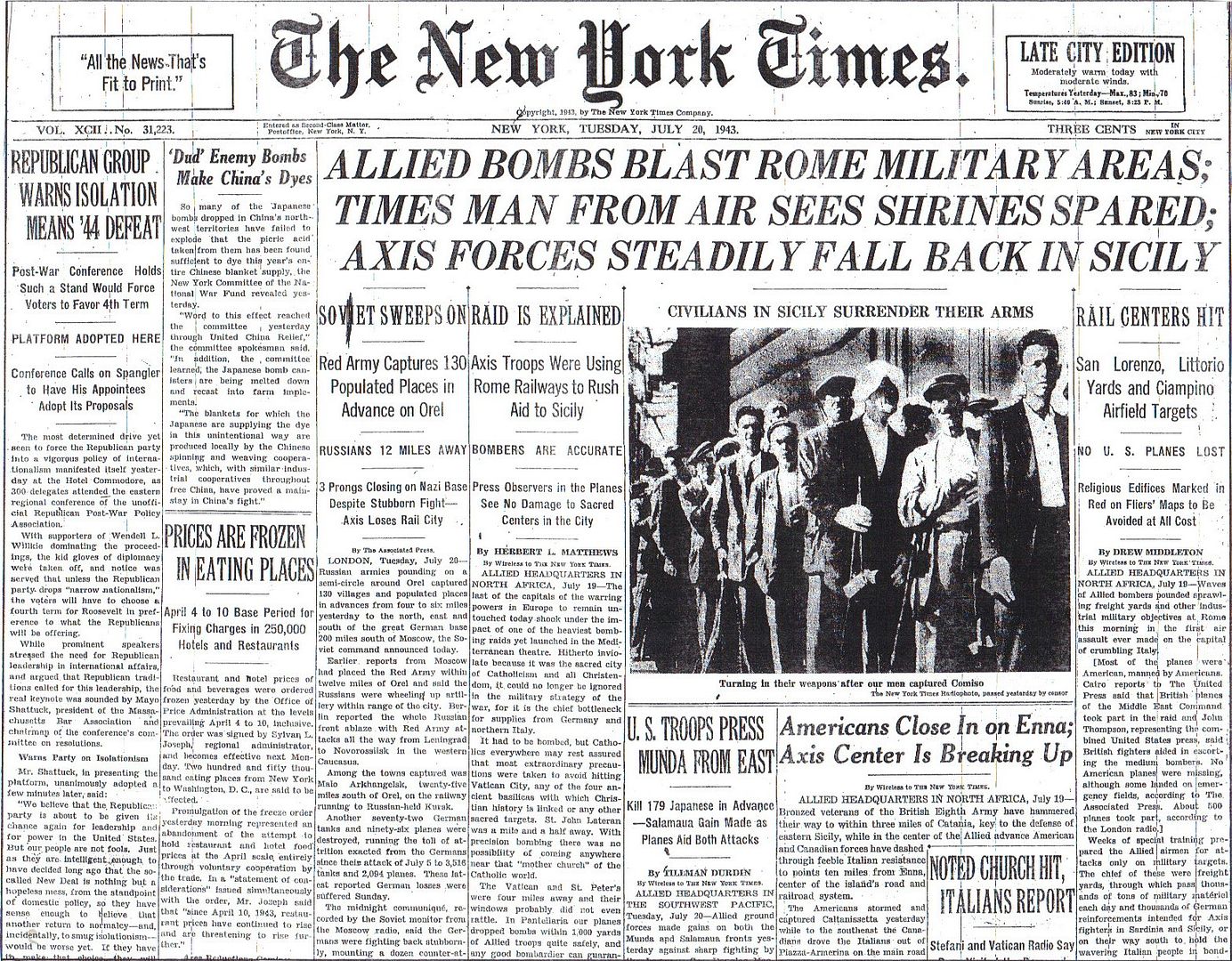
Posted on 07/20/2013 6:00:59 AM PDT by Homer_J_Simpson

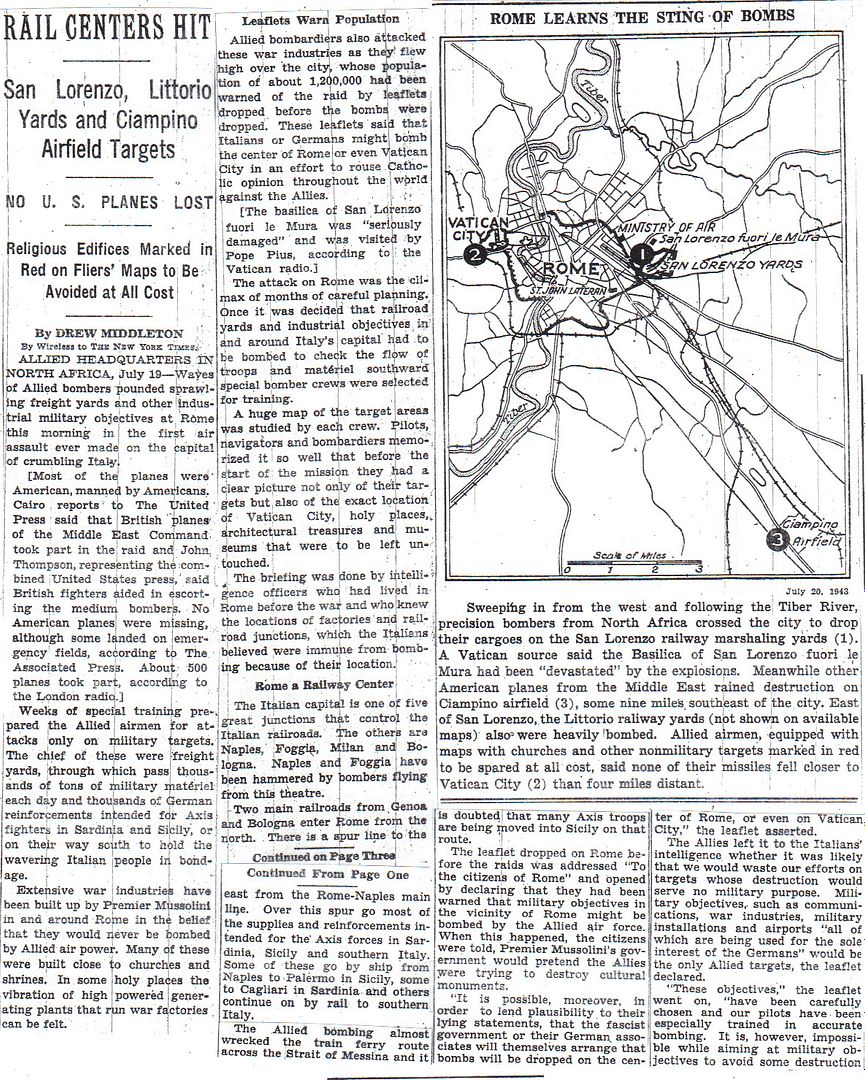
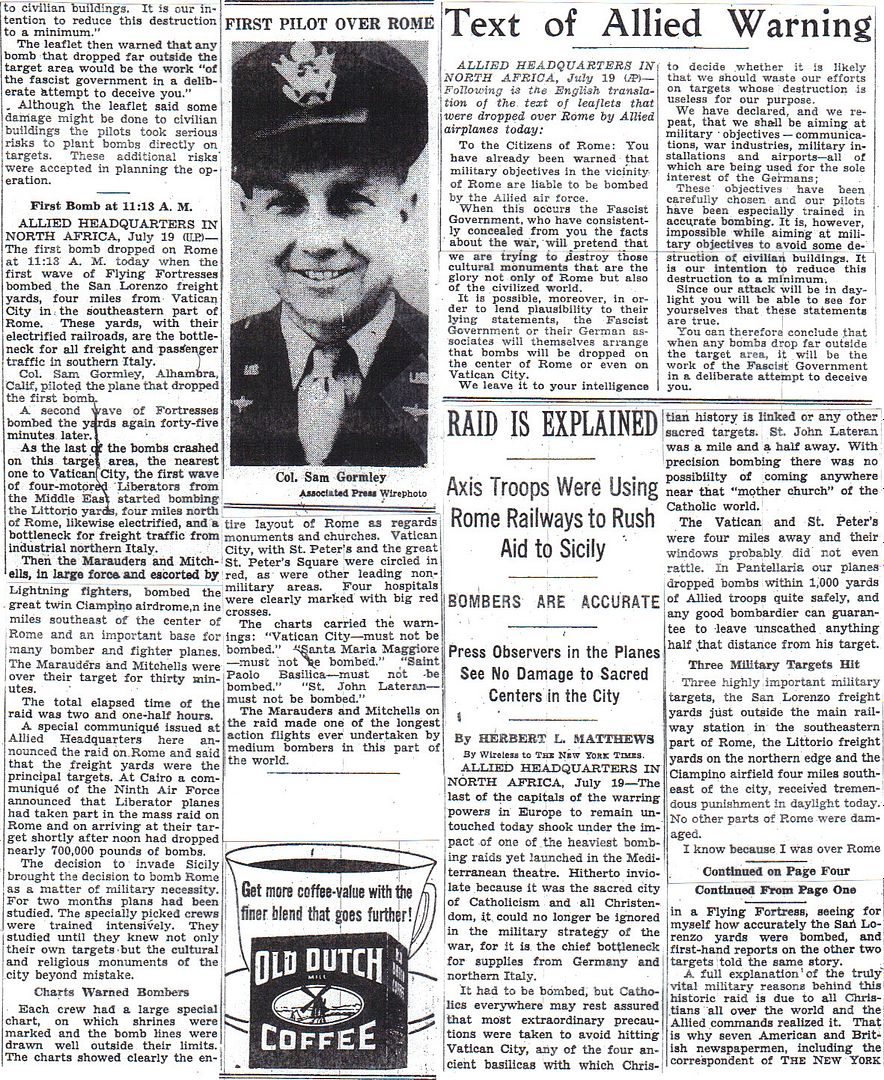
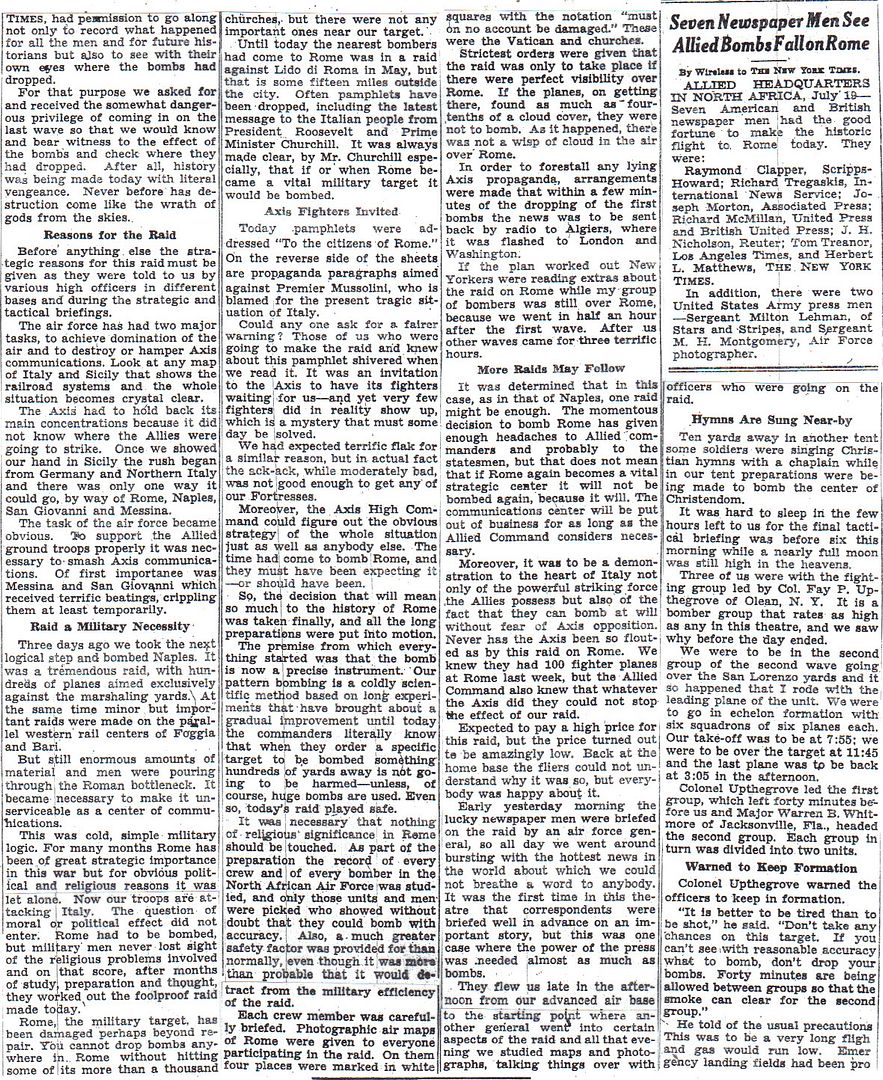
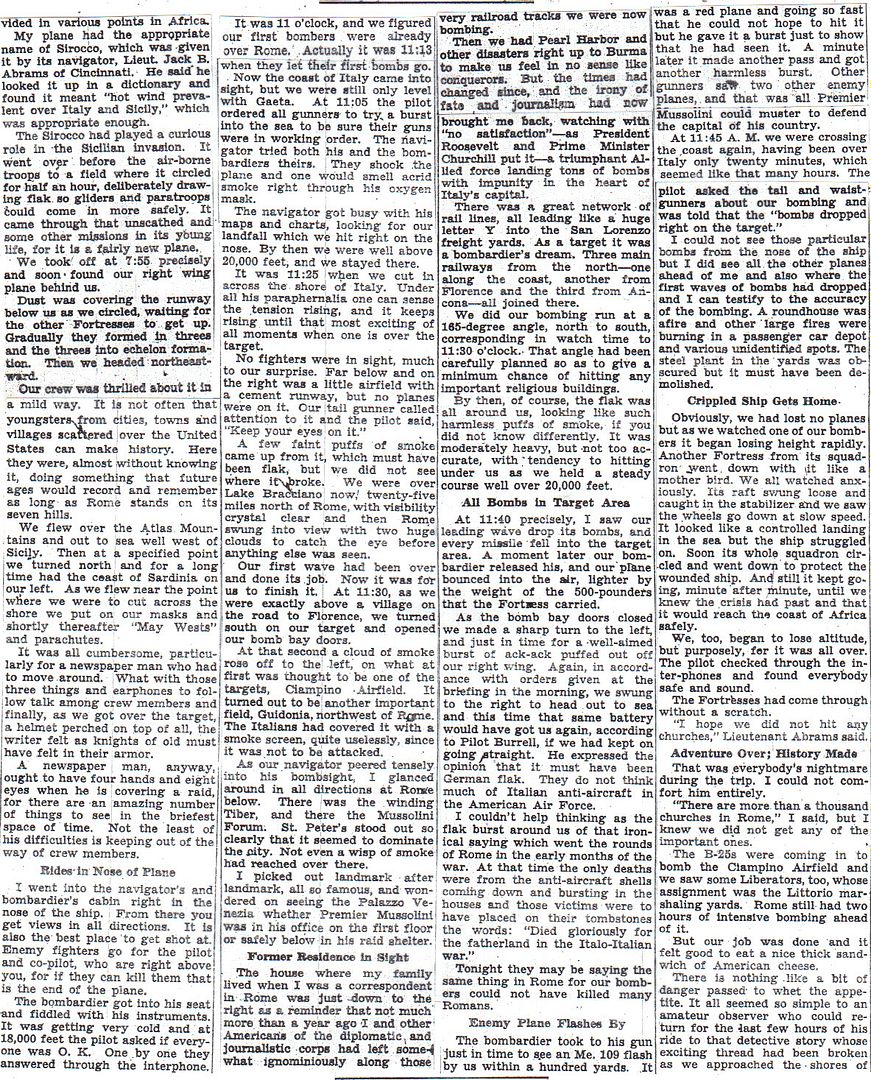
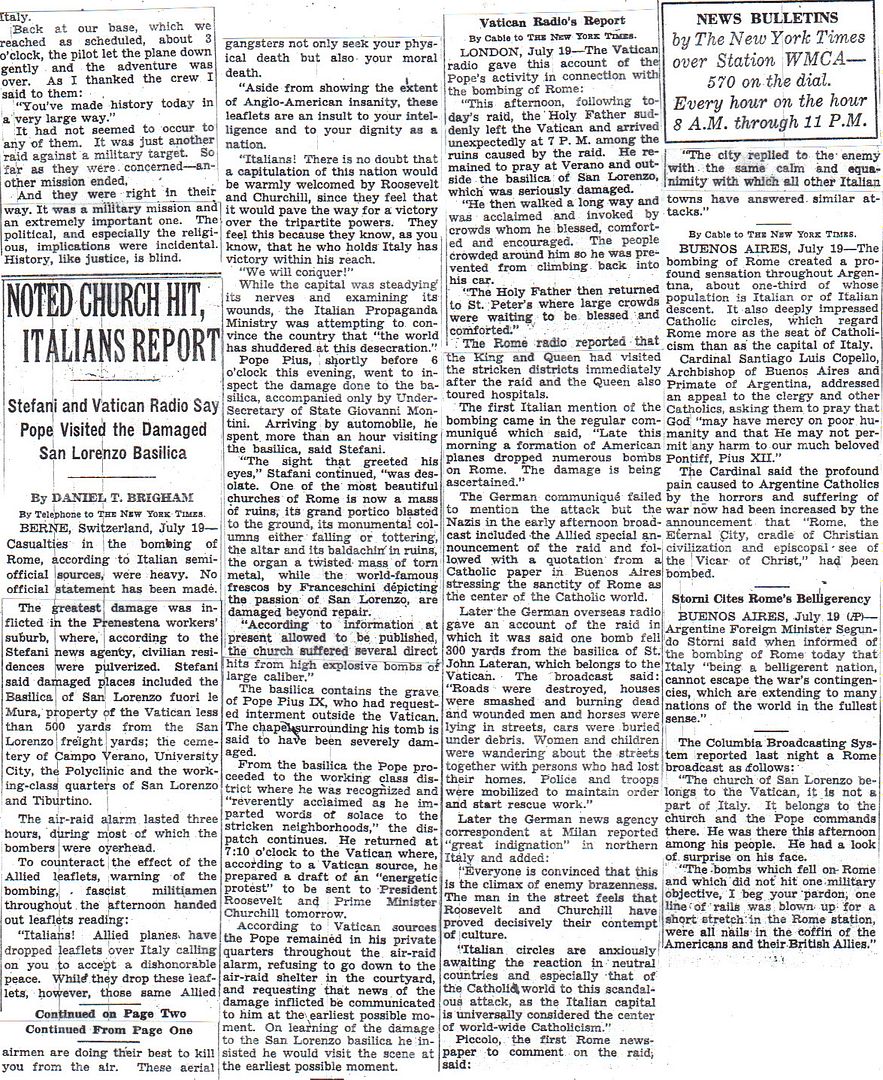
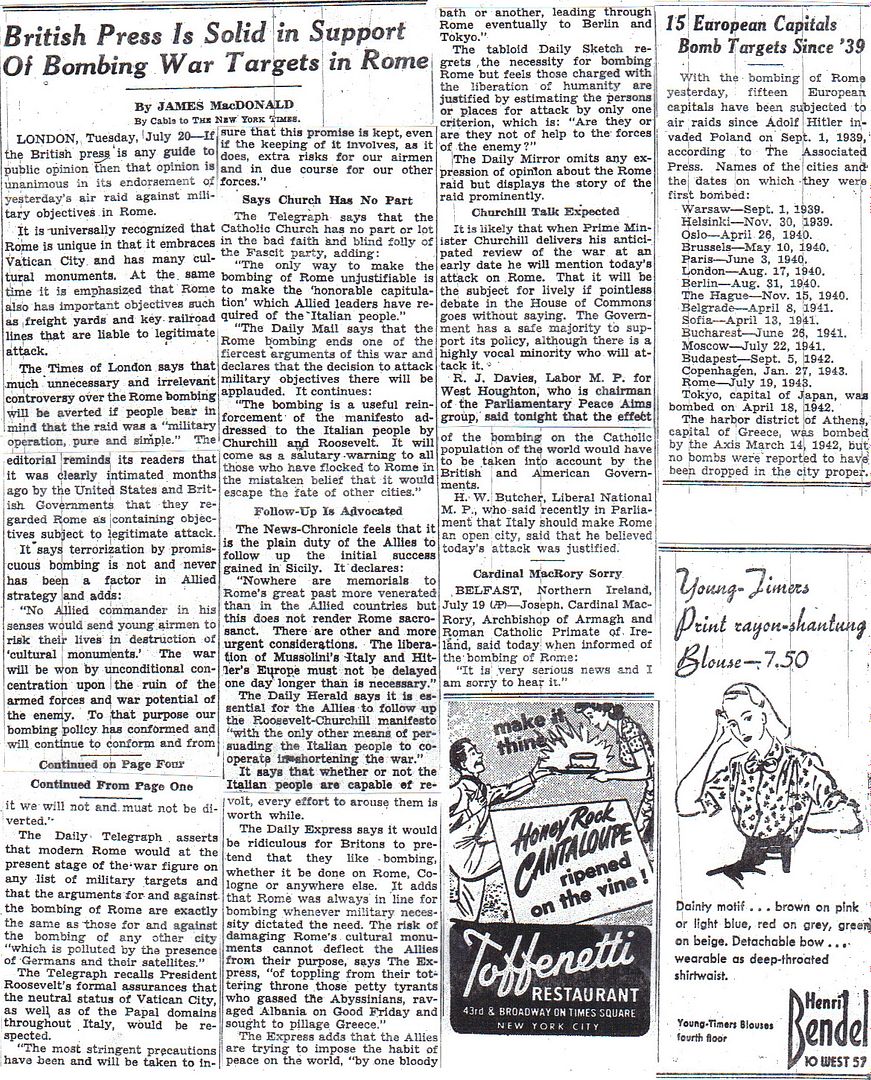
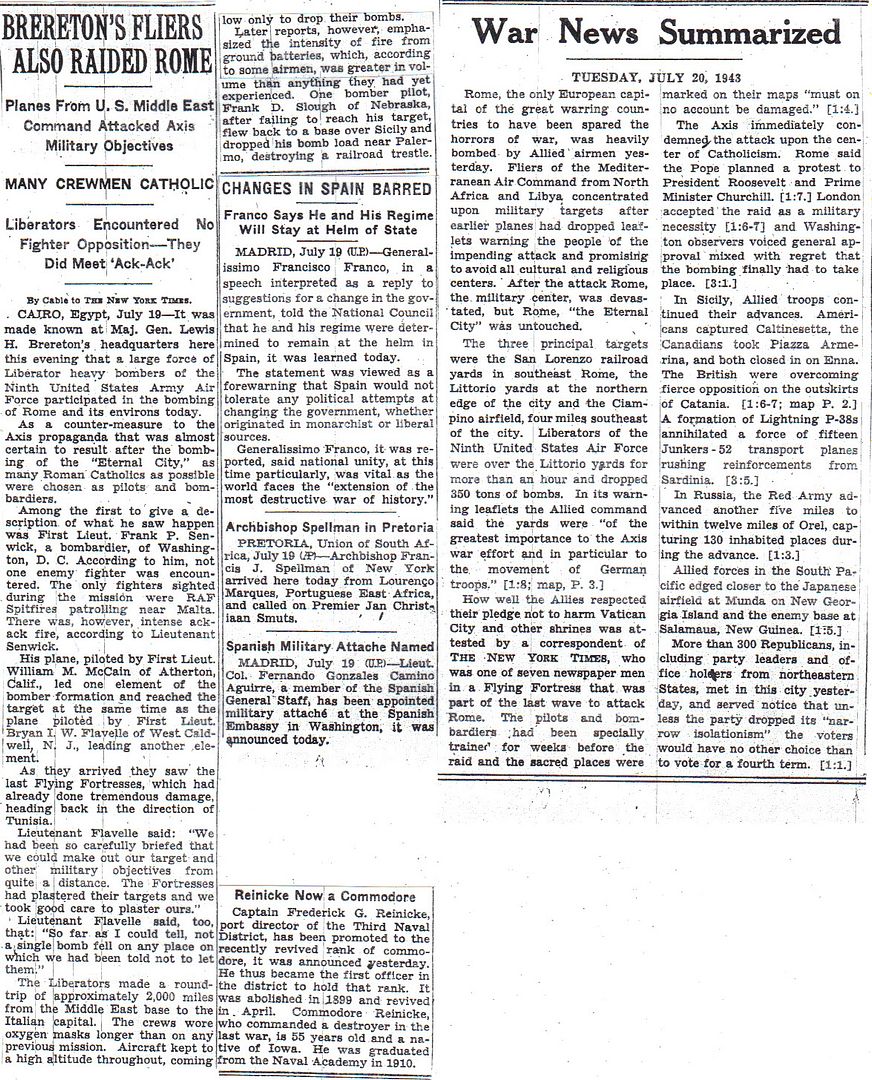
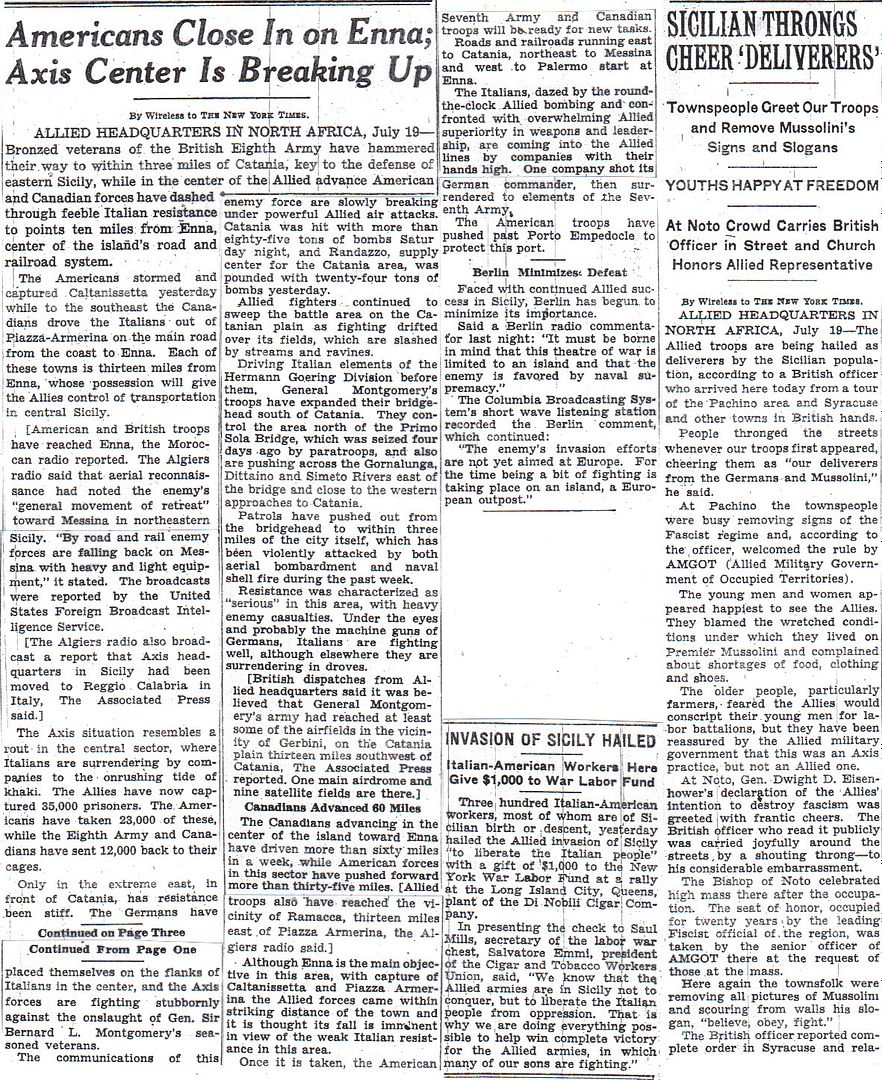


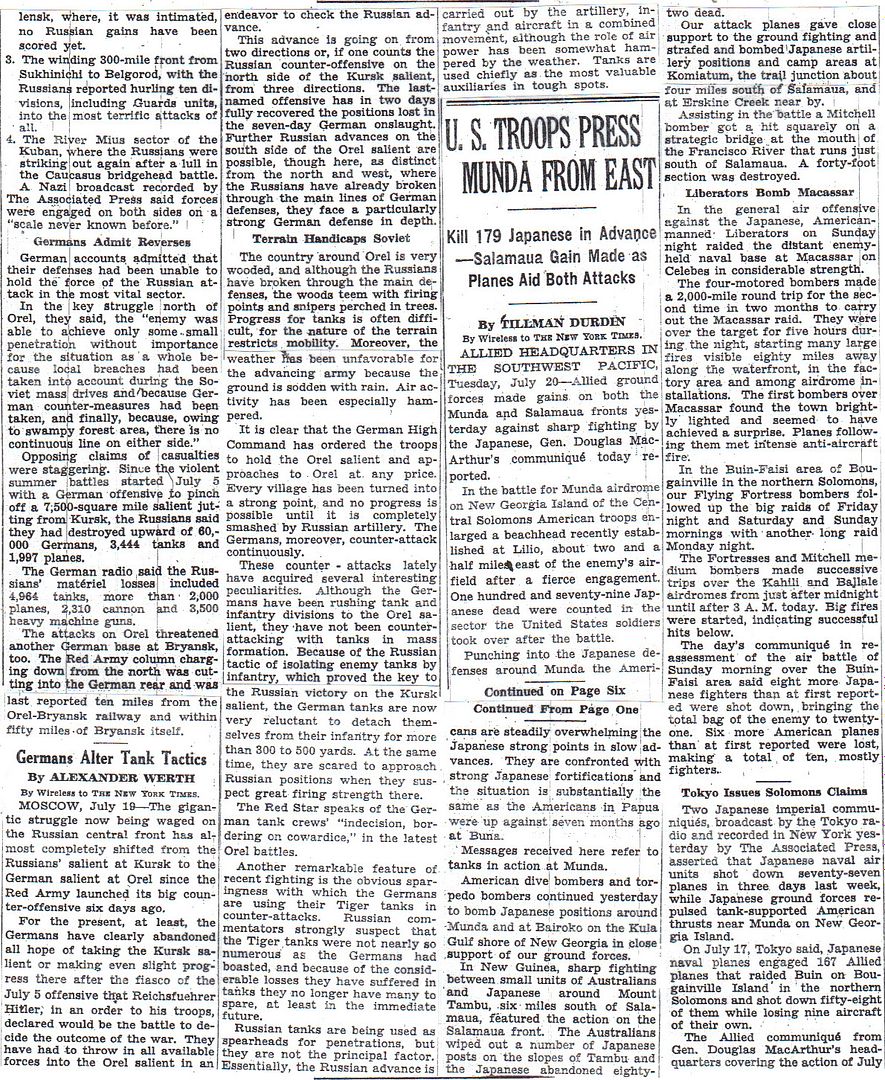
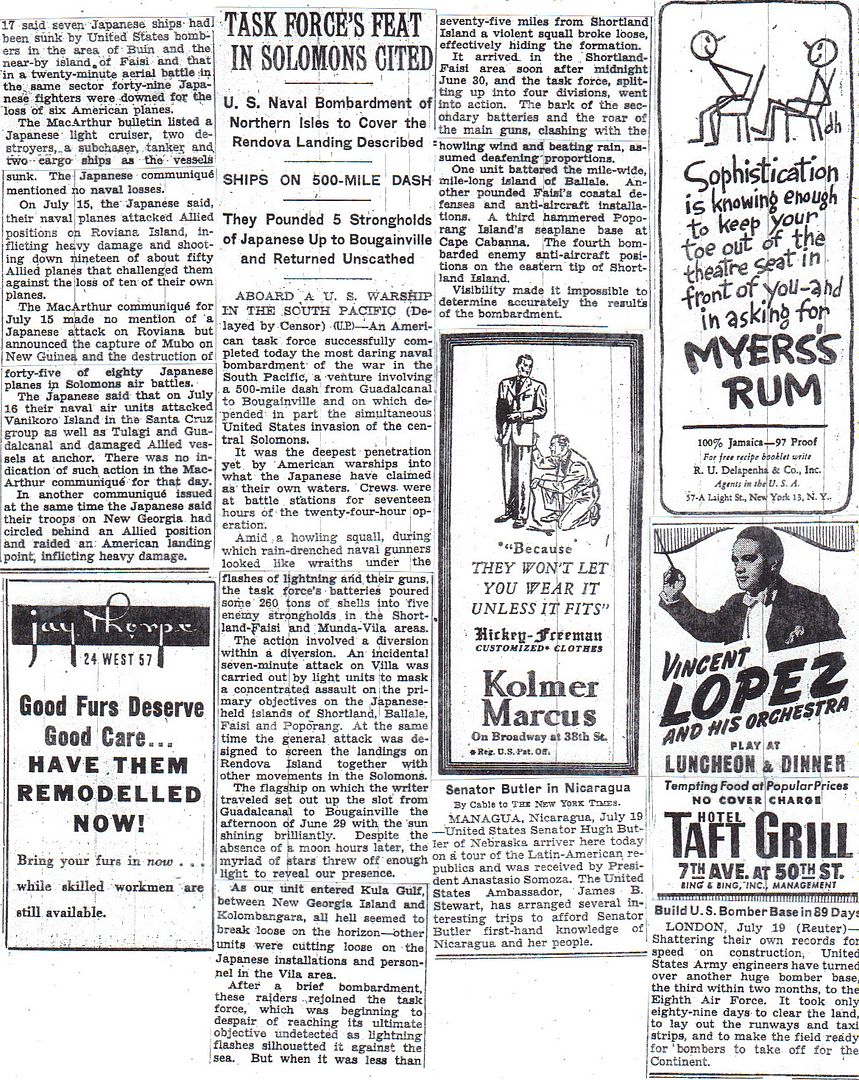
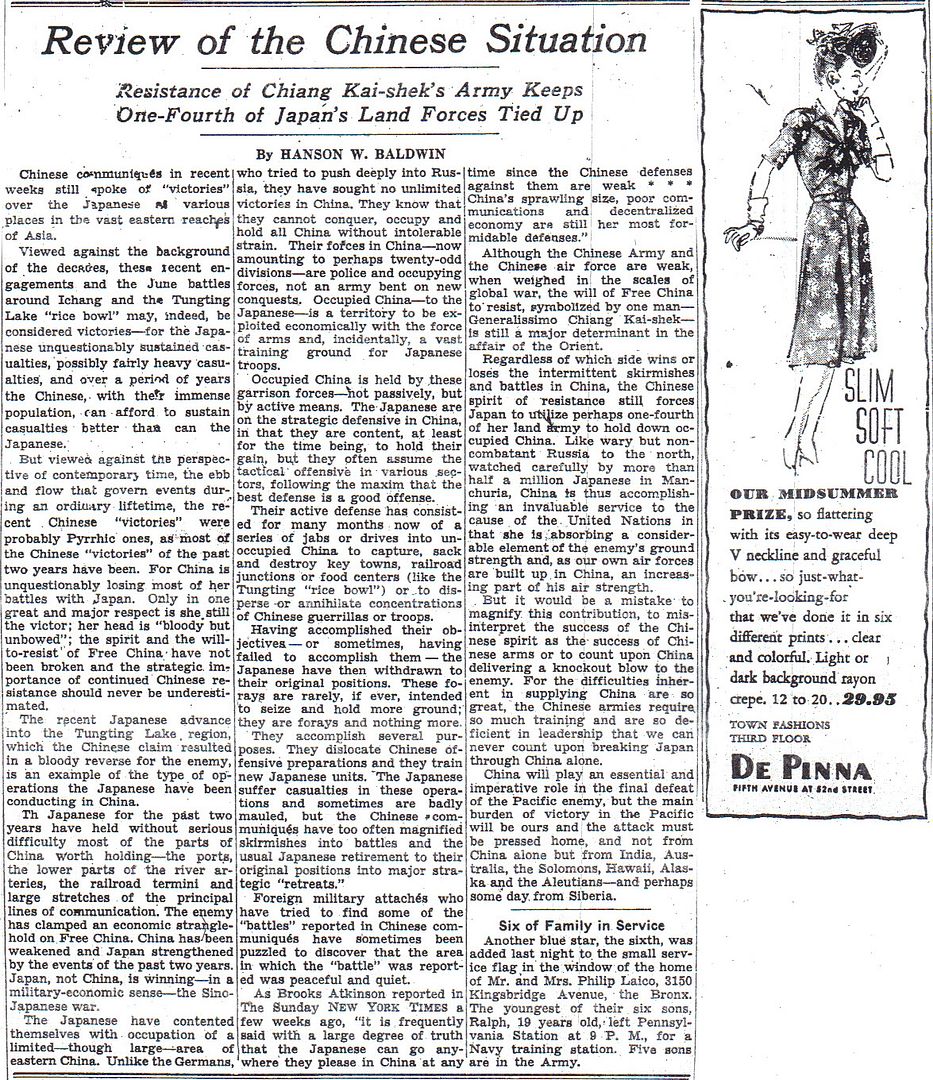
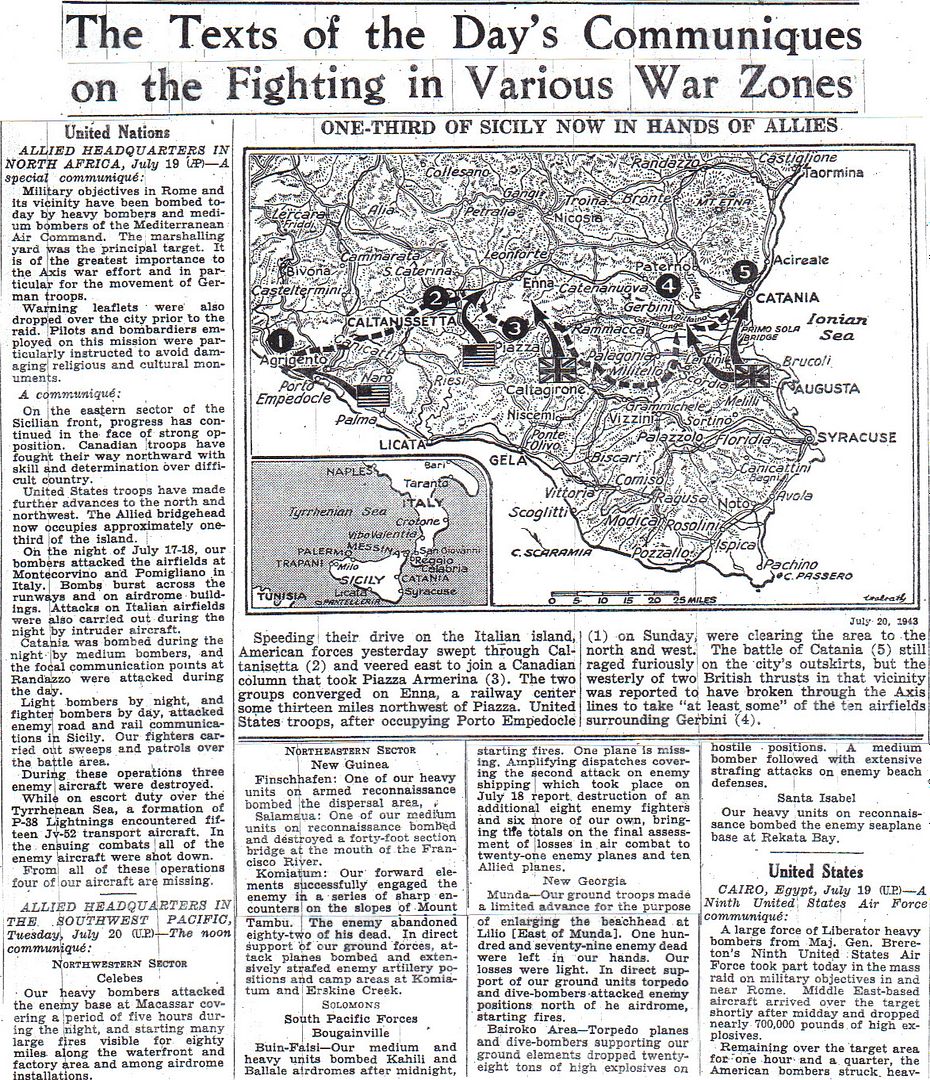

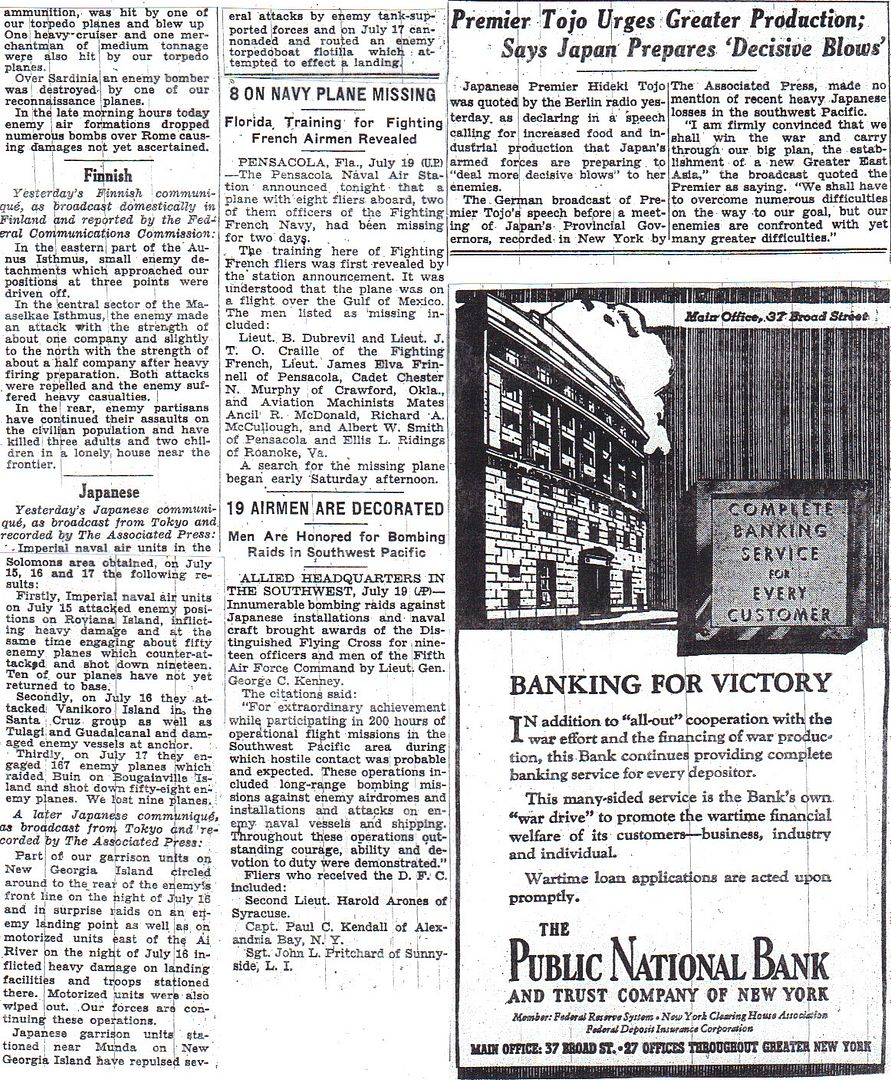
http://www.onwar.com/chrono/1943/jul1943/f20jul43.htm
Allies advancing in Sicily
Tuesday, July 20, 1943 www.onwar.com
Canadian troops take Enna [photo at link]
In Sicily... Canadian troops capture Enna and advance to Leonforte. American troops reach Menfi in the south of the island.
In Washington... Roosevelt directs that information about atomic research is to be shared with the British.
On the Eastern Front... Popov’s Bryansk Front captures Mtsensk.
In the Solomon Islands... New American forces take over the front on New Georgia. New road construction alleviates the supply problem. Two Japanese destroyers are sunk during a supply mission.
http://www.etherit.co.uk/month/thismonth/20.htm
July 20th, 1943 (TUESDAY)
UNITED KINGDOM: Submarines HMS Spirit and Vampire launched.
Escort carrier HMS Ameer commissioned.
GERMANY: U-242, U-292, U-1165 launched.
ITALY: On the ground in Sicily, the US Seventh Army and British Eighth Army continue to push northwest and north. The US 82d Airborne Division takes Sciacca and Menfi; the US 9d Infantry Division clears Santo Stefano Quisquina and the heights north of Mussomeli; the US 2d Armored Division, with British units, takes Enna and drives on to Villapriolo. The Canadian 1 Division pushes to the Leonforte area; the British 51 Division attacks the German airfield near Sferro; 13 Corps is halted by strong opposition on the Catania Plain.
During the night of 19/20 July, Northwest African Strategic Air Force (NASAF) Wellingtons bomb Aquino, Sicily, and Capodichino, Italy, Airfields while Northwest African Tactical Air Force (NATAF) medium and light bombers attack vehicles, roads, and town areas around and in Randazzo, Santo Stefano di Camastra, Orlando, and Nicosia, Sicily. During the day, NASAF fighter-bombers attack targets of opportunity in western Sicily while NASAF medium bombers strike Montecorvino Airfield. Joining the attack are USAAF Ninth Air Force B-25s which attack Randazzo and Taormina; and RAF heavy bombers which hit Vibo Valentia Airfield.
U.S.S.R.: Soviet forces, under heavy fire from the Luftwaffe, push the Germans out of Mtensk.
The National Committee for a Free Germany broadcasts its manifesto to the German people and army.
Moscow: The STAVKA has issued an order to all partisans units declaring a “rail war” against the German railway system. From now on every effort will be made to prevent supplies and reinforcements reaching the front. The Germans have already been forced to use armoured trains to fight off partisan attacks and many units have suffered severe casualties on the way to the front. Now, the railways are going to become even more hazardous.
SOLOMON ISLANDS: - 18 Thirteenth Air Force B-24s bomb airfields at Kahili on Bougainville Island and on Ballale Island.
During the night of 19/20 July,USNPBY Catalinas and eight USMC TBF Avengers attack an IJN surface force between Vella Lavella and Choiseul Islands sinking a destroyer and damaging a heavy cruiser and a destroyer. During the day, USAAF”> USAAF B-25 Mitchells sink another destroyer.
- Navy PBY Catalinas spot a Japanese task force coming down “The Slot” and it is attacked by Marine TBF Avengers which sink a destroyer and damage a cruiser. A second wave of B-25 Mitchells and TBFs attack without success but a third wave of B-25s sink a destroyer using skip-bombing techniques. Fighters strafe barges in Pakoi Bay, New Georgia Island.
Territory of Hawai’i: The underground oil storage facility at Red Hill, Pearl Harbor is completed. (Edward S. Miller)
ALEUTIAN ISLANDS: In the Aleutian Islands, the destroyers USS Aylwin (DD-355) and USS Monaghan (DD-354) bombard Kiska Island with 100 rounds each of 5-inch (127 mm) shells.
CANADA: Frigates HMCS Prestonian and Sea Cliff laid down Lauzon, Province of Quebec.
Corvettes HMCS Asbestos and Hawkesbury laid down Quebec City, Province of Quebec.
Tug HMCS Glenlea launched Owen Sound, Ontario.
U.S.A.: President Roosevelt issues a firm order that atomic information should be shared with the British. There will be staff discussions on this topic at the Quebec Conference next month.
Escort carrier USS Nehenta Bay laid down.
Escort carrier USS Natoma Bay launched.
Minesweeper USS Sway commissioned.
Frigate USS Sausalito launched.
Destroyer escorts USS Burke and Scott commissioned.
ATLANTIC OCEAN: German submarine U-558 is sunk in the Bay of Biscay northwest of Cape Ortegal, Spain, in position 45.10N, 09.42W, by depth charges from an RAF Halifax Mk II of No. 58 Squadron and a USAAF B-24 Liberator of the 19th Antisubmarine Squadron (Heavy); both aircraft are based at St. Eval, Cornwall, England. Only 5 of the 50-man sub crew survive.
One man was lost (Matrosenobergefreiter Arthur List) during an air attack on U-195 in the Bay of Biscay.
I've read various explanations over the years. Too bad a p-38 ace in the Pacific wasn't transferred to Europe to fly p-38 and give us an apples-apples comparison.
The 109, 190, and 205 were better than the Zero. And the Japanese wasted their good pilots and were unable to replace them.
In what respects? The Zero was more nimble than any of the German fighters.
Of course, the maneuverability of the Zero came at the expense of armor but ME-109 wings weren't noted for their strenght and the concentrated fire from a p-38 was going to do serious damage to anything that got in it's way.
Wiki has a good explanation under the P-38 Operational History European Theater:
https://en.wikipedia.org/wiki/Lockheed_P-38_Lightning#Operational_history
Thanks.
From the Wiki:
American fuel supplies contributed to a better engine performance and maintenance record
I've read this many times that the p-38's Allisons were designed for American aviation fuel which had different characteristics including higher octane that the aviation gas in the European Theater.
If inferior aviation gas was the p-38's nemesis in Europe, I've never understood why no one raised holy hell about it?
The gas issue was more of problem for the Axis with the few P-38’s they captured.
I get from the article that the P-38 was inferior at low altitudes compared to it’s German adversaries.
One of the problems with the P-38 in Europe was that it suffered from an inferior heating-defrosting system. At high altitude during bomber escort missions, the canopy would fog/ice up and cause the pilot visual problems along with the distraction of trying to scrape it off.
Obviously, that was no problem in the Pacific.
Yet we don't hear complaints about its performance in North Africa when it was encountering arguably better German pilots than it would face in the latter years of the war.
Comparing p-38 maintenance and performance reports across theaters would be an interesting topic for someone to research and write, or produce a documentary about.
I suspect it was some combination of fuel, air conditions, plane complexity, production and logistics that resulted in the p-38s flown over Continental Europe not performing as well as in other theaters.
For example, in the Pacific where I believe aviation fuel was all the same American blend and presumably matched what the Allison engines were designed for, how reliably did the p-38 perform in the Aleutians versus South Pacific? How did p-38 maintenance and performance in the cold, wet Aleutians compare with p-38 maintenance and performance in the cold wet conditions of northwestern Europe?
If Merlins were performing better over continental Europe than the Allisons, did anyone ever discuss taking a p-38 and replacing its Allisons with Merlins just to see what happened?
I also wonder to what extent egos were involved? Berlin was well within escort range of p-38s based in England but US Air Force doctrine going into the war was that heavy bombers didn't need fighter escorts.
By 1943, the 8th Air Force was being slapped in the face by the cold hard hand of reality. Bomber losses were high and no one planned production for large numbers of fighter escorts.
So, saying no long range fighter escort was available in 1943 was technically true but that was only because p-38 production did not factor in a need for large numbers of heavy bomber escorts.
Valid point about no/poor cockpit climate control. However, p-38s were used heavily in the Aleutians and I don't recall ever reading of engine performance problems in those cold, wet conditions.
They had more opportunities to perform in the other theaters
There were some biases that worked against the P-38 in England that played a role with its more limited use. The genesis of this might well lay with the first lot of P-38Es that were delivered to the R.A.F. in 1941. These first models did not have the counter rotating propellers or superchargers. This really took some of the fine handling characteristics away from the aircraft.
This British sentiment was bolstered by Major General James E Chaney who was commander on U. S. Army forces on the British Isles before the establishment of ETOUSA. He didn't like the thought of using the P-38 as a fighter either. When he found out that many of the fighter groups being assigned to England were to be fitted with the 38 and the P-39 he wrote Air Marshal Portal with his doubts of the use of the P-38 in England. He claimed that it was better suited as an interceptor to shoot down enemy bombers rather than an air superiority fighter.
Finally, there is a timing issue here as well. As Eaker was trying to equip his pursuit units he knew that the bulk of the P-38s being sent to Europe would end up going to the African/Med theater. He therefore requested that the P-47 be designated as his long range escort fighter (with drop tanks they could go a fair way but not quite as far as the P-38). So in a way, the P-38 was muscled out in England by a another very good aircraft. When the P-51 started showing up with the Merlin/RR engine, then there was even less room for the Lightning.
In doing a little bit of poking around concerning this question I ran across this dissertation by Bernard Boylan on the Air Force Historical Research Agency's website. I only skimmed it of course, but it looks like it is worth revisiting and reading in full.
I'm sure that really soured the British attitudes towards the p-38 and caused them to regard it in the same obsolete class as the German Me-110. I wonder if the British were aware that what they received was a stripped down "export" version of the p-38?
This British sentiment was bolstered by Major General James E Chaney who was commander on U. S. Army forces on the British Isles before the establishment of ETOUSA. He didn't like the thought of using the P-38 as a fighter either. When he found out that many of the fighter groups being assigned to England were to be fitted with the 38 and the P-39 he wrote Air Marshal Portal with his doubts of the use of the P-38 in England. He claimed that it was better suited as an interceptor to shoot down enemy bombers rather than an air superiority fighter.
Chaney may too have been prejudiced by those stripped down p-38s delivered to the British in 1941.
There is still the matter of aviation gas blend used in England that I have read about over the years contributing to performance issues with the p-38s Allison engines.
Finally, there is a timing issue here as well. As Eaker was trying to equip his pursuit units he knew that the bulk of the P-38s being sent to Europe would end up going to the African/Med theater.
I guess the question here is did Eaker even try to keep his fighters? I ask this because by late 1942 he was on record (per the document you provided) pounding the table saying no fighters were needed to escort his heavy bombers.
He therefore requested that the P-47 be designated as his long range escort fighter (with drop tanks they could go a fair way but not quite as far as the P-38). So in a way, the P-38 was muscled out in England by a another very good aircraft.
The p-47 was a very good airplane. However, if I remember correctly, the p-47 had less than half the combat radius of the p-38 and didn't begin arriving in England until 1943 which was after Eaker had given up all his p-38s to Africa/Mediterranean.
That the p-47 had greater range than the Spitfire was probably a plus in Eaker's mind but even with drop tanks the p-47 couldn't go to Berlin and back but Eaker didn't believe such escort capability necessary.
When the P-51 started showing up with the Merlin/RR engine, then there was even less room for the Lightning.
The p-51 did have a little more range than the p-38 but when going up against the Me-262, the p-38 was slightly faster than the p-51 and the p-38 could outclimb the Me-262 whereas the p-51 couldn't touch the Me-262 in a climb.
I also think in these latter years of the war, logistics played an important role in the p-51 surpassing the p-38. For the material that went into a p-38, you could almost produce two p-51s.
In doing a little bit of poking around concerning this question I ran across this dissertation by Bernard Boylan on the Air Force Historical Research Agency's website. I only skimmed it of course, but it looks like it is worth revisiting and reading in full.
Thanks. That is a great read. I haven't finished it but will do so shortly. Interesting little nuggets I've already come across are:
p14 An account written by Gen "Hap" Arnold and Gen. Eaker is an example of the pre-war Air Corps outlook regarding heavy bombers:
"The bombing formations will come persistently onward as relentless as the waves of the sea. The fighting and pursuit planes will soon exhaust their fuel supply, cease their attacks, and land for servicing, but the bombers will complete their missions and return to their bases to take more bombs for other operations. Once more the pursuit planes will rise to the attack and endeavor to halt the seemingly endless stream of hostile bombers until the defending airmen are exhausted and the losses of planes become so great that the few effectives remaining can be brushed aside with little or no effort. The bombers keep coming."p46
"in May (1939) the Chief of the Air Corps directed that no tactical plane be equipped with a droppable tank."p58
"Early in May (1942) when Chaney learned that American fighter groups were to be equipped with P-38's and -39's, he wrote Air Marshal Portal that he gravely doubted if they were suitable for escort missions. He suggested that the American units, instead, be assigned Spitfires, and that a like number of Kittyhawks (P-40) be sent to the British in the Middle East."p60 in July 1942
"Elements of the 1st Fighter Group crossed the Atlantic Ocean in two B-17's and eight P-38's, the longest flight of fighter planes up to that time. Brig. Gen Frank O'D. Hunter, Commanding General of VIII Fighter Command, and his staff landed at Prestwick, Scotland on July 27 (1942) after having made the trip via Goose Bay, Labrador, Greenland, Iceland, and Stornoway, Scotland."p61
in December (1942) the 78th Group, equipped with p-38's arrived in the United Kingdom, but early in 1943 all of its planes and 60 of its pilots were transferred to North Africa."p67
in Oct 1942 Gen Eaker, Commander of the 8th Air Force wrote "there was then no evidence to suggest that bomber losses would be so high as to make daylight bombing uneconomical"p68
"He (Gen. Eaker) felt that the bomber force in England could now enter the second phase of its program -- the plan for bombing submarine pens -- which called for deeper penetrations -snip- with bombers proceeding to the targets beyond fighter range. Eaker was anxious to initiate this program, notwithstanding the loss of three p-38 units to North Africa and the Eight's dependence on the short range Spitfires."p68
"Later in October (1942) Eaker reiterated his earlier conviction that daylight bombing was feasible without fighter escort. "You have probably been asked", he wrote to Arnold, "whether it is feasible to bomb objectives in Germany by daylight without fighter cover. I am absolutely convinced that the following measures are sound.... Three hundred heavy bombers can attack any target in Germany by daylight with less than four percent losses."p69
"In the fall of 1942 VIII Bomber Command reviewed its activities and optimistically reported that the B-17 could defend itself against the German fighters, Me-108 and Fw-190. The summary stated that the two German planes are no match for close formations of the B-17 and B-24's in units of 12 or more."p70
"The (autumn 1942) report concluded: One salient fact emerges from any study of German fighter tactics against missions flown to date: no tactics have been evolved capable of inflicting uneconomical losses on units of 12 or more B-17's or B-24's when flown in close formation."p72
"As 1942 drew to a close, VIII Bomber Command could take stock of its small but promising operations. Though only 27 missions had been flown, and none exceeded 79 planes, the B-17 had shown itself the best day bomber to fly in the theater and the P-38 had appeared as the best fighter plane for escorting bombers."And those same p-38 the Eaker said were his best escorts would soon be sent to Africa.
p74
"The Eighth Air Force was responsible for the transportation of the units destined for North Africa. This movement encompassed the dispatch of 1,072 aircraft, including 412 P-38's".
"the p-38, once in Africa became the outstanding fighter in the theater. Its performance in ground strafing, fighter sweeps and reconnisance proved it to be the most versatile plane in the campaign. But it was in the role of an escort plane that the p-38 was regarded as unique. The p-38 quickly became the plane almost exclusively used to escort both heavy and medium bombers because of its superior range."p76 In the spring of 1943 Gen Doolittle in North Africa wrote the following to Gen. Hap Arnold
"Our only problem in connection with the use of the p-38 is that there are not enough of them and it does not appear that there ever will be."
Thanks again for the link. This is a great read.
Book after book and documentary after documentary always point to the lack of long range fighter as if the p-38 never existed. They portray the p-51 as the great savior of the Eighth Air Force and responsible for turning the tide in the skies over Europe.
Based on what I've already read in the document you linked to, I'm leaning towards Air Corps brass going into the war with a mindset of heavy bombers not needing fighter escort. The relatively light bomber losses in small 1942 coastal "milk runs" (non-German targets) made by the 8th confirmed in many minds that fighters were not needed to escort formations of heavy bombers.
So, 8th Air Force brass agreed to permanently let go of their p-38s.
Later, in 1943 as the 8th began striking into Germany proper with larger formations of bombers, the Germans countered by sending up larger numbers of fighters than had been the case in 1942 during the small flights of bombers raiding coastal (non-German) targets.
The problem for the 8th in 1943 was it had already given up its p-38s and made no demands for their return. So, it had to make do with the modest combat radius of the p-47.
I didn't see anything mentioned on the fuel issue. I do know that American fuel was higher octane which certainly would have made any engine run better and it stands to reason that the Allison engine would be design to use this fuel.
Eaker was all over the place with his opinion on fighters. A colleague of mine is what I would call an expert on the 8th Air Force and he describes Eaker as almost bi-polar. He was a lot like many of the bomber generals of the time, initially feeling that the bombers could protect themselves and that the fighters couldn't go as far as the bombers anyway making them moot, but in the end he saw the light (and the reduction of bomber losses) by using escorts. He will get his first hard lesson in this next month.
He didn't have a problem giving up the P-38s to the Med, but then suddenly wanted something to replace them, ergo the request for P-47s (he got the first ones in April of 43)
You know, I think too much is made of the Me-262 in World War II. No doubt it was a giant leap in aircraft technology with the introduction of a jet propelled fighter but it just never was produced in enough numbers to have a significant impact. In May of 1944 when they were just starting to become operational the III Gruppe of Zerstörergeschwader 26 (ZG 26) had only 7 Me-262s and only 1 of them were operational.
By September of 44 that number had only increased to 91 but 52 of them were assigned to bomber units (Kampfgeschwader 51) and only 37 of those were operational. The rest were assigned to a night fighter unit. (Nachtjagdgeschwader 11)
In the end they still didn't exist in great numbers. From the sources I have this is the disposition of the Me-262 on April 9th, 1945:
Day fighter units:
JG 7 - 76 planes, 53 operational
KG(J)- 54 - 37 planes, 21 operational
JG 400 - 30 planes, 15 operational
Night fighter units:
NJG 11 - 9 planes, 7 operational
Tactical reconnaissance units:
NAGr. 6 - 7 planes, 3 operational
Bomber units:
KG 51 - 21 planes, 13 operational
So there still were less than 100 of them operating as fighters at the end of the war. They were a terror in the sky (if I remember right most of them were shot down while taking off or landing) but it was too little too late to have any real impact against the thousand bomber missions they were up against.
LOL! Glad to have helped out. I would have continued through the section of Africa/Med and the Pacific but was eager to finish the dissertation. I did finish reading it today and really enjoyed it. Thanks again for posting the link.
I didn't see anything mentioned on the fuel issue.
I didn't either.
I do know that American fuel was higher octane which certainly would have made any engine run better and it stands to reason that the Allison engine would be design to use this fuel.
I'll see if I can find anything interesting concerning the fuel issue. Over the years when having these type discussions about the under utilization of p-38s by the 8th Air Force, the topic of aviation fuel in Britain has come up but I've never seen anything conclusive regarding it.
He didn't have a problem giving up the P-38s to the Med, but then suddenly wanted something to replace them, ergo the request for P-47s (he got the first ones in April of 43)
Something I found to be jaw dropping was that had the Luftwaffe challenged the p-51/47/38 along the coast of France and the Low Countries and thereby forced external fuel tanks to be jettisoned, deep strike fighter escorts would not have been possible.
p207
Underlying the problems which beset the Germans in their conduct of air defense was their inability to comprehend implications of the escort fighter. At best, the American escort fighter was a modified interceptor type plane, which even with increased internal fuel capacity could not have accompanied bombers in deep penetrations had the Germans challenged the fighters at the coast of France and forced them to drop the jettisonable tanks. General Anderson stated the point thus:You know, I think too much is made of the Me-262 in World War II. No doubt it was a giant leap in aircraft technology with the introduction of a jet propelled fighter but it just never was produced in enough numbers to have a significant impact.In terms of the reaction to the wing tanks to our P-51's and P-47's here again he (Goering) had the opportunity to apply his forces which were causing the fighter forces so much concern at a time when the fighter forces had tanks on their wing tips.Now when a P-51 had a tank on its wing tip, then if a Luftwaffe Me-109 or Fw-190 didn't have any tactical advantage over it, there was nothing left for them (the Germans) to do but surrender, to give up.
But they did have the tactical advantage there; they could have forced the stripping. It was a tactical mandate that they force the stripping of the wing tanks as near the Channel shores as possible with the forces necessary to achieve that stripping.
Having that (external tanks) stripped, they (Luftwaffe) could move back in and meet the undefended bombers over the target area and have exacted a heavy toll. But they decided it was better to meet the enemy with his wing tanks over a target area and they gave us free access to the deeper targets before we had to strip these tanks.
These were gifts; therse were gratuities from Goering and his staff, and they make major contributions to the seeming success and the tactical soundness of the application, the commitment of the so called daylight strategic Air Forces.
We owe much to Goering for the lessons, the sucessful lessons that we got in the war.
The result of this tactical blunder permitted American bombers and fighters to go as far as Berlin oftentimes before jettisoning fuel tanks.
At that point conflict was in order, but the Germans had denied themselves full employment of their own fighters on the periphery of Germany proper. Had they forced escorts to drop their tanks on the coast, the Germans would have seen bombers flying the same long stretch of deep penetrations alone, with the probable repeat of the reception which had awaited American planes when they struck Schweinfurt and Regensburg in August and October, 1943.
And it's use was only practical because Germany was on defense.
So there still were less than 100 of them operating as fighters at the end of the war. They were a terror in the sky (if I remember right most of them were shot down while taking off or landing) but it was too little too late to have any real impact against the thousand bomber missions they were up against.
Yep. Like the Tiger Tank, the Me-262 was expensive, unreliable and never available in sufficient numbers to materially effect the outcome.
I don’t mean to butt in as you guys have had a terrific discussion here. You’ve really cleared up a lot of questions I had regarding the use of the P-38 in the European Theater. I’m glad I stopped in because I learned something new.
In regard to the Me-262, I had a conversation with a German history buff some time ago. He said the main problem with making the 262 operational in any great numbers was the materials necessary for the turbine blades in the Jumo-004 jet engine. I can’t remember offhand, but it was the sort rarer metal the Germans just didn’t have much of. They also had very short operational lives. As with any new technology, there were a lot of dead ends and necessary refinement before it becomes effective and readily available. Engine availability, performance and maintenance probably had the most to do with why the Germans didn’t have very many 262s operational at any one time.
And Cougar, 183 books is nothing. I’ve probably read that many in the past decade alone...oh, by December? That’s different. Why are you wasting time reading this?
If you haven't already started doing so, read that dissertation on long-range fighter escort that CougarGA7 linked to a few posts earlier. It is a gold mine of information. The first several pages are hard to read due to bad photocopy but they aren't particularly interesting either. The rest of the document is very readable.
As with any new technology, there were a lot of dead ends and necessary refinement before it becomes effective and readily available.
Agreed. The Germans had to proceed forward with development of the Me-262 and other jet aircraft. One wonders though if they might have been better in the short term to put a little more effort into an interesting design using more proven technologies like the Dornier Do 335?
Disclaimer: Opinions posted on Free Republic are those of the individual posters and do not necessarily represent the opinion of Free Republic or its management. All materials posted herein are protected by copyright law and the exemption for fair use of copyrighted works.